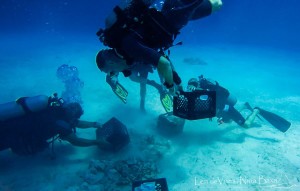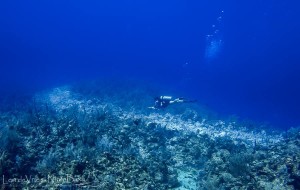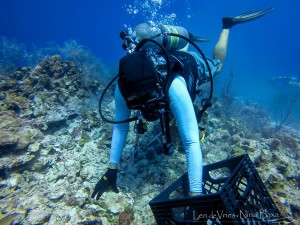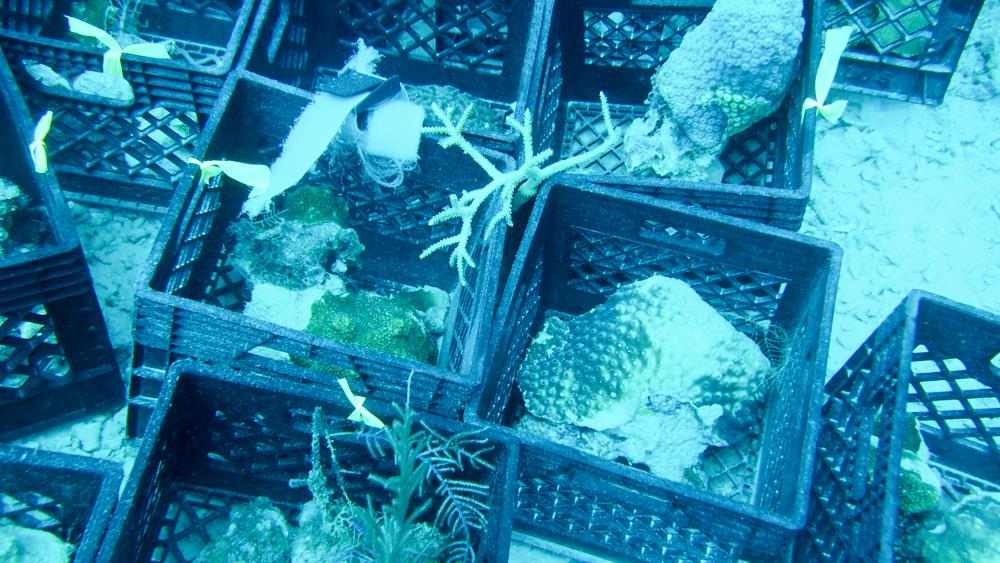News
Cayman Dive Operators and Volunteers Work Against Time to Restore Damaged Coral Reef

Coral Reef Devastated By Cruise Ship’s Anchor
In the waters off George Town, Grand Cayman, a group of approximately 50 volunteer divers led by local dive operators, and guided by the Cayman Islands Department of Environment (DOE), are working tirelessly to repair a coral reef severely damaged by a cruise ship anchor in mid-August. Working in teams with designated leaders, following project coordinators under the direction of the DOE, the divers are carefully removing the rubble, dead coral and sediment, crate by crate, knowing that time is critical.
“Right now it’s basic triage, and any live corals are being put aside for reattachment once the rubble is removed,” says Ocean Frontiers’ Lois Hatcher, who is trained and experienced in coral restoration. “Every day that goes by, more coral that is buried or heavily covered in sediment, is suffocating. They need sunlight and a stable substrate to survive, so the longer they are unstable, the survival rate decreases.”
Hatcher and Keith Sahm, Sunset House General Manager, are coordinating the structured project, guided by the Department of Environment. They are making sure the work is done carefully, methodically and safely. Both stepped up after they heard the news that the Carnival Magic accidentally dropped its anchor on the dive site. Frustrated by lack of immediate action, Sahm organized an emergency meeting on the 18th September at Sunset House and an overflow crowd of volunteers showed up motivated and ready to go to work knowing that time is critical and government manpower is short. Two days after the meeting, the volunteers made their first dive on the site, saw the extent of the damage and realized what they are up against.
“The chain damage is just terrible! The captain had let out 5 shots of chain – about 450 feet – with each link weighing between 50 – 100 pounds,” says Keith Sahm. “It’s a sickening feeling to know that thousands and thousands of years of coral growth has been demolished by an error in judgment, or mechanical problems.”
“A lot of man-hours are needed to restore a reef – first with the triage, then the reattachment and maintenance,” says Lois Hatcher, adding that it could take up to a year to complete. “We are also hoping to start a couple of nursery trees for the long-term keeping of live coral fragments, as they grow faster this way and can then be used to embellish what coral was replanted.
The goal is to execute a coral restoration project similar to the one carried out in 1996 when the Maasdam cruise ship dropped its anchor on a shallow dive site in George Town damaging 7500 square feet of the reef. That restoration project, conducted by local divers, including Lois Hatcher and the Department of Environment, took about 9,000 hours of underwater work over three months. Officials say that coral bed could take more than sixty years to grow back. The Carnival Magic has damaged almost 12,000 square feet of reef located in deeper water, so the volunteer army has its work cut out for it.
 “We are all just volunteers, so I applaud absolutely everyone’s effort here,” says Sahm. “Thank goodness we have folks like Peter Milburn and Lois Hatcher that worked on the 1996 project and are still here to help. And a special thanks to the Marine Conservation Board for easing guidelines and laws so we can do this restoration work – it’s unlawful for anyone to touch or pick up coral, dead or alive in the Cayman Islands. We wouldn’t be able to do this important work without the help of the Board and Department of Environment.”
“We are all just volunteers, so I applaud absolutely everyone’s effort here,” says Sahm. “Thank goodness we have folks like Peter Milburn and Lois Hatcher that worked on the 1996 project and are still here to help. And a special thanks to the Marine Conservation Board for easing guidelines and laws so we can do this restoration work – it’s unlawful for anyone to touch or pick up coral, dead or alive in the Cayman Islands. We wouldn’t be able to do this important work without the help of the Board and Department of Environment.”
The restoration work is difficult and exhausting, but everyone involved knows it will pay off in the years to come. While the dive site won’t be what it was originally, restoration can at least make the reef stable enough to sustain life again. The rubble also needs to be removed as soon as possible to prevent further damage when the next big storm kicks up.
While an investigation into the Carnival Magic incident is conducted, the repair work at the site continues non-stop and to date, more than 20 dives have been made, and volunteers have put in 150 man-hours. Communication and coordination are done through a Facebook page that now has 265 followers. Boat trips are scheduled and volunteers, both locals and visitors, can sign up to help. The challenge for Sahm and Hatcher will be keeping up the enthusiasm and pace of the repair work during the months ahead.
 According to the Coral Restoration Foundation (CRF), a nonprofit conservation organization, the key to a successful project is to engage the community, something that is now taking place on Grand Cayman. Sunset House, Ocean Frontiers, Red Sail Sports, Divetech, Don Foster’s Dive and other local operators are providing boats and tanks for the dozens of volunteer divers. Southern Cross Club staff in Little Cayman will participate during an upcoming trip to Grand Cayman. Foster’s Food Fair, a local grocer, has donated the plastic milk crates being used to remove the rubble, while the local Subway has provided free sandwiches for the restoration crew. The hope, according to Sahm and Hatcher, is to encourage long-term involvement and partnerships that will keep the momentum going.
According to the Coral Restoration Foundation (CRF), a nonprofit conservation organization, the key to a successful project is to engage the community, something that is now taking place on Grand Cayman. Sunset House, Ocean Frontiers, Red Sail Sports, Divetech, Don Foster’s Dive and other local operators are providing boats and tanks for the dozens of volunteer divers. Southern Cross Club staff in Little Cayman will participate during an upcoming trip to Grand Cayman. Foster’s Food Fair, a local grocer, has donated the plastic milk crates being used to remove the rubble, while the local Subway has provided free sandwiches for the restoration crew. The hope, according to Sahm and Hatcher, is to encourage long-term involvement and partnerships that will keep the momentum going.
 “This is something we really need to do as a community, try to repair the damage to this beautiful reef,” says Hatcher. “If nobody’s going to be held accountable for this, we have to be accountable for it.”
“This is something we really need to do as a community, try to repair the damage to this beautiful reef,” says Hatcher. “If nobody’s going to be held accountable for this, we have to be accountable for it.”
Team leaders and coordinators met with a Department of Environment officer on Monday for a project review, and according to the DOE, the results are encouraging because of the progress that has already been done.
The project has an on-going need for more volunteers. Anyone interested in helping is asked to visit the Facebook page Cayman Magic Reef Recovery where volunteer dives and updates are continually posted.
Gear News
Introducing the TR-80, IR-50 and CS-30 Regulators from DYNAMICNORD

Whether you are a beginner or a professional diver – with the three new main regulators from DYNAMICNORD, everyone will find their favourite regulator. They all look super stylish.
Excellent performance with the TR-80
Quality and performance are the be-all and end-all for regulators. It is not for nothing that the TR stands for Tec Reg. The innovative design of the TR-80 guarantees absolute reliability – even in ice-cold waters.

Perfect breathing effort at 0.8 J/l / certified for diving in waters below 10 degrees / structural design made of solid brass for best cold protection / membrane-compensated design with dry seal of the first stage / reduced exhalation effort thanks to optimized exhalation membrane and bubble deflector / adjustable Venturi (dive/predive) and adjustment knob for individual inhalation comfort / innovative design of the front cover prevents free-flow in strong currents or when diving with scooters / design made of sandblasted brass, matt chrome finish / 2 HP and 4 LP outlets / mouthpiece made of high-quality, anti-allergic silicone for maximum comfort.


Amazing underwater adventures with the IR-50
The IR-50 is the top regulator for advanced and experienced divers. Natural breathing is the essence of this regulator.

Ideal breathing effort at 0.8 J/l /certified for diving in waters below 10 degrees / compensated membrane / adjustable venturi (dive/predive) and adjustment knob for individual inhalation comfort/ outlet valve and deflector for minimum exhalation effort and reduction of bubbles on the face / design made of sandblasted brass, matt chrome finish / 2 HP and 4 NP outlets / mouthpiece made of high-quality, anti-allergic silicone for maximum comfort.


The Workhorse – our CS-30
For diving centres and diving beginners – the workhorse stands for strong construction, reliability and robustness. Perfect for your training.

Optimal breathing effort at 0.8 J/l /recommended for diving in waters above 10 degrees / non-compensated piston / adjustable venturi (dive/predive) / outlet valve and deflector for minimum exhalation effort and reduction of bubbles on the face / design made of sandblasted brass, matt chrome finish / 1 HP and 3 NP outlets / mouthpiece made of high-quality, anti-allergic silicone for maximum comfort.


Octopus OP-30
The OP-30 is the ideal addition to all DYNAMICNORD regulators. It is identical in construction to the CS-30.

The TR-80, IR-50, CS-30 (DIN & INT) regulators and the Octopus OP-30 are available from DYNAMICNORD dealers and in the online store.
DYNAMICNORD – Your Outdoor Companion.
Marine Life & Conservation
Paul Watson Released as Denmark Blocks Japan’s Extradition Bid

Renowned anti-whaling activist Paul Watson has been released from custody in Greenland after spending five months in detention. Denmark’s Justice Ministry rejected Japan’s request for his extradition, citing insufficient guarantees that his time already served in custody would be credited against any potential sentence.
The 74-year-old Canadian-American was arrested on July 21 in Nuuk, Greenland’s capital, when his ship docked to refuel. His arrest was based on a 2012 Japanese warrant related to a 2010 encounter in Antarctic waters. Japan alleged Watson obstructed operations and caused damage to a whaling research ship during efforts to disrupt illegal whaling. Watson has consistently denied these claims, maintaining his commitment to marine conservation.
Denmark, which oversees extradition matters for Greenland, concluded that while the legal conditions for extradition were met, the lack of assurances from Japan regarding time-served credit made extradition untenable.
In a video shared by his foundation, Watson expressed gratitude and relief, saying, “After five months, it’s good to be out… and good to know they’re not sending me to Japan.” He added that the most difficult part of his time in custody was being separated from his two young sons.
Watson is a pioneering figure in marine conservation, known for founding the Captain Paul Watson Foundation in 2022 after decades of activism with the Sea Shepherd Conservation Society. His bold efforts to defend marine life have earned him widespread support, including from celebrities and conservationists. His work has also been featured in the acclaimed reality TV series Whale Wars.
Watson’s lawyer, Jonas Christoffersen, praised the decision, stating, “We are happy and relieved that Paul Watson is now free.” He added that Watson is eager to reunite with his family and continue his vital work.
The arrest occurred while Watson’s vessel, the M/Y John Paul DeJoria, was en route to the North Pacific with a team of 26 volunteers to intercept a Japanese whaling ship. His foundation described the arrest as politically motivated and emphasized that Watson’s actions were focused on ending illegal whaling practices.
Japan resumed commercial whaling in 2019 after leaving the International Whaling Commission, asserting that whale meat is a cultural tradition. Conservationists, however, continue to challenge these practices, highlighting their impact on marine ecosystems.
Despite the challenges, Watson remains steadfast in his mission to protect marine life and bring attention to whaling practices. His dedication to ocean conservation has made him a globally respected advocate for the environment.
-

 News2 months ago
News2 months agoIconic SS United States to become the World’s Largest Artificial Reef
-

 News3 months ago
News3 months agoBook Review – 52 Assignments: Underwater Photography
-

 Gear News3 months ago
Gear News3 months agoDYNAMICNORD – New German diving brand enters the British market
-

 News3 months ago
News3 months agoExploring Cenote El Pit: A Diver’s Dream
-

 Gear News3 months ago
Gear News3 months agoTry BARE drysuits (and maybe even win one!) this Friday with Sea & Sea at North West Dive Fest
-

 Marine Life & Conservation3 months ago
Marine Life & Conservation3 months agoBook Review: Coral Triangle Cameos
-

 Blogs2 months ago
Blogs2 months agoDive the Egyptian Red Sea this Autumn with Regaldive
-

 News3 months ago
News3 months ago2024 Ocean Art Underwater Photo Competition Announced



















